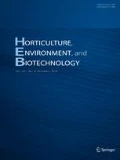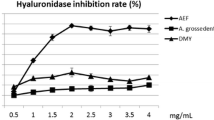Abstract
The fruit of trifoliate orange (Poncirus trifoliate) is widely used for treating allergies including allergenic dermatitis and inflammation in oriental medicine. Increased blood IgE concentration and histamine level following dermatitis, coughing and asthma are the most important clinical symptoms of allergic diseases. Decreases in the elevated serum IgE concentrations are essential in the treatment of allergy because increased IgE blood levels are initiated in allergenic immune disorders. This study was conducted to investigate the activities of an extract of trifoliate orange fruit using 100% methanol followed by extraction with boiling water on the regulation of blood IgE concentration in the U266B1 human myeloma cell line and a 1-chloro-2,4-dinitrobenzene (DNCB) sensitized mouse model. The results revealed that the extracts of trifoliate orange suppressed IgE production in U266B1 cells in a dose dependent manner with or without lipopolysaccharide (LPS) stimulation of the cells. In addition, chemically elevated blood IgE concentrations were dramatically decreased by oral administration, ventral injection, and topical application of the trifoliate orange extracts (TOE). The results indicated that the fraction of TOE should contain an important compound of the fruit of trifoliate orange, and TOE had the ability to reduce IgE concentrations in cultured cells and a chemically sensitized in vivo mouse model.
Similar content being viewed by others
Literature Cited
Al-Turki, S., S. Mohamed, P. Forsline, and C. Stushnoff. 2008. Biodiversity of total phenokics, antioxidant capacity, and juice quality in apple cider taxa. Hort. Environ. Biotechnol. 49:409–417.
Akdis, C.A. 2006. Allergy and hypersensitivity: mechanisms of allergic disease. Curr. Opin. Immunol. 18:718–726.
Arbona, V., Z. Hossain, M.F. Lopez-Climent, R.M. Perez-Clemente, and A. Gomez-Cadenas. 2008. Antioxidant enzymatic activity is linked to waterlogging stress tolerance in citrus. Physiol. Plant 132:452–466.
Burrows, B., F.D. Martinez, M. Halonen, R.A. Barbee, and M.G. Cline. 1989. Association of asthma with serum IgE levels and skin-test reactivity to allergens. N. Engl. J. Med. 320:271–277.
Dearman, R.J., J.M. Hegarty, and I. Kimber. 1991. Inhalation exposure of mice to trimellitic anhydride induces both IgG and IgE antihapten antibody. Int. Arch. Allergy Appl. Immunol. 95:70–76.
Dearman, R.J. and I. Kimber. 1991. Differential stimulation of immune function by respiratory and contact chemical allergens. Immunology 72:563–570.
Dearman, R.J., E.V. Warbrick, R. Skinner, and I. Kimber. 2002. Cytokine fingerprinting of chemical allergens: species comparisons and statistical analyses. Food Chem. Toxicol. 40:1881–1892.
Gerberick, G.F., C.A. Ryan, P.S. Kern, R.J. Dearman, I. Kimber, G.Y. Patlewicz, and D.A. Basketter. 2004. A chemical dataset for evaluation of alternative approaches to skin-sensitization testing. Contact Dermatitis 50:274–288.
Ha, K.T., J.K. Kim, Y.C. Lee, and C.H. Kim. 2004. Inhibitory effect of Daesungki-Tang on the invasiveness potential of hepatocellular carcinoma through inhibition of matrix metalloproteinase-2 and -9 activities. Toxicol. Appl. Pharmacol. 200:1–6.
Heyman, B. 1990. The immune complex: possible ways of regulating the antibody response. Immunol. Today 11:310–313.
Hong, J., H.Y. Min, G.H. Xu, J.G. Lee, S.H. Lee, Y.S. Kim, S.S. Kang, and S.K. Lee. 2008. Growth inhibition and G1 cell cycle arrest mediated by 25-methoxyhispidol A, a novel triterpenoid, isolated from the fruit of Poncirus trifoliata in human hepatocellular carcinoma cells. Planta Med. 74:151–155.
Jayaprakasha, G.K., K.K. Mandadi, S.M. Poulose, Y. Jadegoud, G.A. Nagana Gowda, and B.S. Patil. 2007. Inhibition of colon cancer cell growth and antioxidant activity of bioactive compounds from Poncirus trifoliata (L.) Raf. Bioorg. Med. Chem. 15:4923–4932.
Jung, S.H., Y.S. Lee, S.S. Lim, Y.S. Kim, S.H. Lee, and K.H. Shin. 2009. Hepatoprotective and antioxidant capacities of paecilomyces japonica and cordyceps sinensis in rats with CCL4-induced hepatic injury. Kor. J. Hort. Sci. Technol. 27:668–672.
Kahlert, H., A. Petersen, W.M. Becker, and M. Schlaak. 1992. Epitope analysis of the allergen ovalbumin (Gal d II) with monoclonal antibodies and patients’ IgE. Mol. Immunol. 29:1191–1201.
Kim, H.M., H.J. Kim, and S.T. Park. 1999. Inhibition of immunoglobulin E production by Poncirus trifoliata fruit extract. J. Ethnopharmacol. 66:283–288.
Larche, M., C.A. Akdis, and R. Valenta. 2006. Immunological mechanisms of allergen-specific immunotherapy. Nat. Rev. Immunol. 6:761–771.
Lee, Y.M., C.Y. Kim, Y.C. Kim, and H.M. Kim. 1997. Effects of Poncirus trifoliata on type I hypersensitivity reaction. Am. J. Chin. Med. 25:51–56.
Na, H.J., H.J. Jeong, W. J. Hwang, K. H. Cho, and H. M. Kim. 2003. Effect of Poncirus fructus on stem cell factor-induced mast cell migration. Pharmacol. Res. 48:267–271.
Park, S.H., E.K. Park, and D.H. Kim. 2005. Passive cutaneous anaphylaxis-inhibitory activity of flavanones from Citrus unshiu and Poncirus trifoliata. Planta Med. 71:24–27.
Pokharel, Y.R., J.E. Jeong, S.J. Oh, S.K. Kim, E.R. Woo, and K.W. Kang. 2006. Screening of potential chemopreventive compounds from Poncirus trifoliata Raf. Pharmazie 61:796–798.
Potter, D.W. and K.S. Wederbrand. 1995. Total IgE antibody production in BALB/c mice after dermal exposure to chemicals. Fundam. Appl. Toxicol. 26:127–135.
Qi, X.F., D.H. Kim, Y.S. Yoon, J.H. Li, D. Jin, Y.K. Deung, and K.J. Lee. 2009. Effects of Bambusae caulis in Liquamen on the development of atopic dermatitis-like skin lesions in hairless mice. J. Ethnopharmacol. 123:195–200.
Romagnani, S. 2004. Immunologic influences on allergy and the Th1/Th2 balance. J. Allergy Clin. Immunol. 113:395–400.
Sears, M.R., B. Burrows, E.M. Flannery, G.P. Herbison, C.J. Hewitt, and M.D. Holdaway. 1991. Relation between airway responsiveness and serum IgE in children with asthma and in apparently normal children. N. Engl. J. Med. 325:1067–1071.
Shin, T.Y., J.M. Oh, B.J. Choi, W.H. Park, C.H. Kim, C.D. Jun, and S.H. Kim. 2006. Anti-inflammatory effect of Poncirus trifoliata fruit through inhibition of NF-kappaB activation in mast cells. Toxicol. In Vitro 20:1071–1076.
Wu, Q.S., R.X. Xia, and Y.N. Zou. 2006. Reactive oxygen metabolism in mycorrhizal and non-mycorrhizal citrus (Poncirus trifoliata) seedlings subjected to water stress. J. Plant. Physiol. 163:1101–1110.
Yi, J.M., M.S. Kim, H.N. Koo, B.K. Song, Y.H. Yoo, and H.M. Kim. 2004. Poncirus trifoliata fruit induces apoptosis in human promyelocytic leukemia cells. Clin. Chim. Acta. 340:179–185.
Zhou, H.Y., E.M. Shin, L.Y. Guo, L.B. Zou, G.H. Xu, S.H. Lee, K.R. Ze, E.K. Kim, S.S. Kang, and Y.S. Kim. 2007. Antiinflammatory activity of 21(alpha, beta)-methylmelianodiols, novel compounds from Poncirus trifoliata Rafinesque. Eur. J. Pharmacol. 572:239–248.
Author information
Authors and Affiliations
Corresponding author
Additional information
These authors are contributed equally to this work.
Rights and permissions
About this article
Cite this article
Park, H.J., Kim, J.B., Han, I.S. et al. Extract of Poncirus trifoliata fruit reduces elevated serum IgE concentrations in chemically induced allergic model mice. Hortic. Environ. Biotechnol. 52, 224–231 (2011). https://doi.org/10.1007/s13580-011-0184-7
Received:
Accepted:
Published:
Issue Date:
DOI: https://doi.org/10.1007/s13580-011-0184-7




